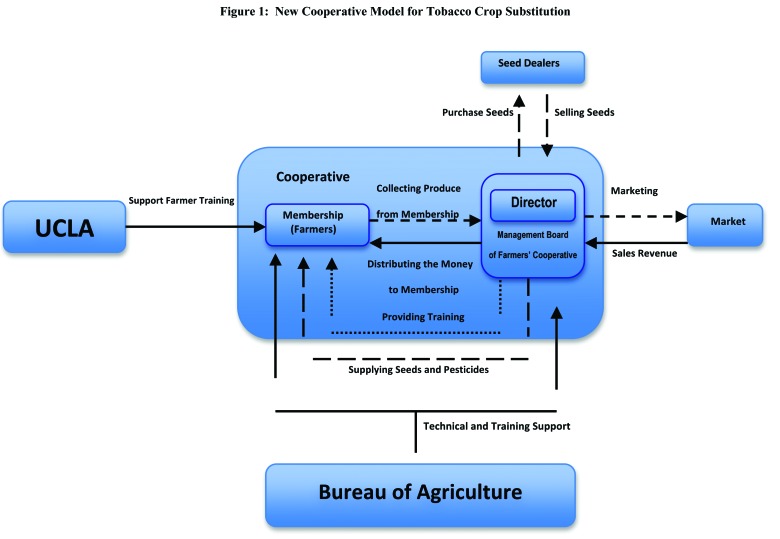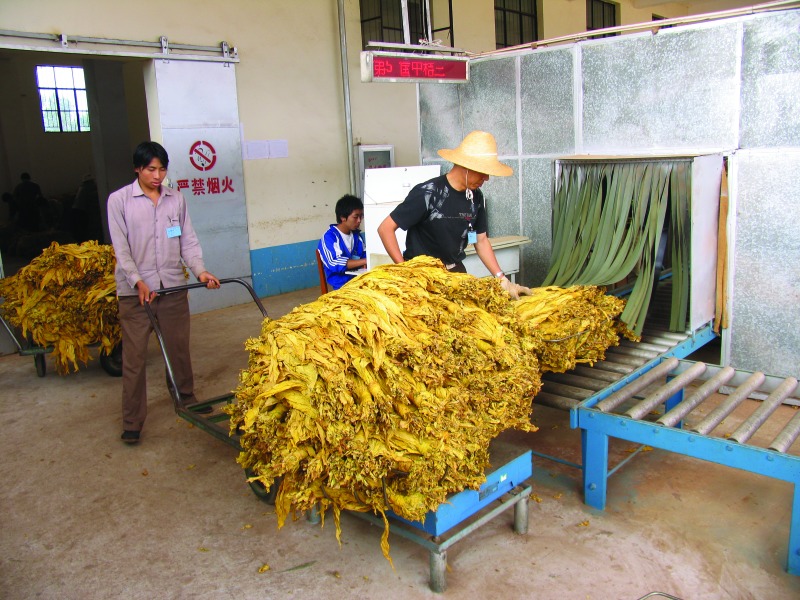Abstract
In China, approximately 20 million farmers produce the world's largest share of tobacco. Showing that income from crop substitution can exceed that from tobacco growth is essential to persuading farm families to stop planting tobacco, grown abundantly in Yunnan Province. In the Yuxi Municipality, collaborators from the Yuxi Bureau of Agriculture and the University of California at Los Angeles School of Public Health initiated a tobacco crop substitution project. At 3 sites, 458 farm families volunteered to participate in a new, for-profit cooperative model. This project successfully identified an approach engaging farmers in cooperatives to substitute food crops for tobacco, thereby increasing farmers’ annual income between 21% and 110% per acre.
KEY FINDINGS
▪China's Yuxi pilot project on tobacco crop substitution and diversification successfully established that farmers, many of whom are not formally educated, were able to learn the knowledge and skills necessary to operate an enterprise that gave them an income superior to that earned from tobacco farming.
▪Farmers at 3 pilot sites engaged in tobacco crop substitution, thereby increasing their annual income by 21% to 110% per acre.
▪This pilot project represents a groundbreaking effort supported by local governments and farmers to move tobacco control efforts upstream.
IN 2003, THE WORLD HEALTH Organization Framework Convention for Tobacco Control put forth the need to provide “support for economically viable alternative” activities for tobacco workers, growers, and sellers.1 China was among the 192 World Health Organization member nations that signed the landmark Framework Convention for Tobacco Control treaty, declaring its commitment to tobacco control from an upstream perspective. That was a milestone choice for a country in which approximately 20 million farmers produce the world's largest share of tobacco.2 In their labor for everyday survival, farmers in China's rural areas face extreme uncertainties on changing their farm livelihood and practice. Here we describe a pilot collaborative effort in Yuxi, China, to enable local farmers to engage in for-profit crop substitution as a means to address the supply side problem.
An important historical note precedes this effort. Tobacco production has increasingly been concentrated in developing countries, and between 1971 and 1997, China's share of the world's tobacco production increased from 17% to 47%.3 Tobacco in China is a state monopoly, which keeps its price artificially low; farmers’ incomes are linked to this dynamic. In this context, enabling farmers to switch to more profitable crops is crucial to decreasing China's tobacco production and to potentially increasing farmers’ standard of living.
China, which imports grain, corn, and beans, also may move toward greater self-sufficiency in its food security by converting tobacco farmland to food crops. In addition, reducing tobacco availability can protect the environment through conserving forests by reducing firewood consumption used for flue curing of tobacco.
Asia's largest cigarette manufacturer, the Hongta Group, is located in southwest China's Yunnan Province in a tobacco-growing municipality called Yuxi. Tobacco production enables Yuxi's economy to rank first in that province, where more than 600 million mu (1 mu equals about 0.23 Western acre) of farmland produce tobacco. The revenue generated has been significant in improving the livelihood of the population engaged in the industry and in providing tax dollars at the local, provincial, and national levels. The average Chinese farmer owns about 1 mu of land, and a family may own 3 to 7 mu. Showing that income from alternative seed selection and crop substitution can generate equal or greater income is essential to persuading farm families to stop growing tobacco.
TOBACCO SUBSTITUTION PILOT PROJECT IN YUXI
The primary objectives of this pilot project were to establish a for-profit farmers’ cooperative operated by those who engage in tobacco crop substitution and to evaluate its effect on farmers’ income.
Beginning in 2008, after encouraging results from a small prepilot study in 2007, the Yuxi Municipality Bureau of Agriculture collaborated with researchers at UCLA Fielding School of Public Health to initiate tobacco crop substitution. The local bureau of agriculture worked with village heads to recruit 458 farm families in 3 sites through announcements at village meetings and word of mouth. Sixty-eight farm families in Hongta District, 156 in Chengjiang County, and 234 in Eshan County volunteered to participate. The total acreages for the 3 sites were 356, 330, and 509, respectively.
Assisted by the local bureau of agriculture, farmers organized a new cooperative model (Figure 1) through which they acquired the necessary skills for accounting, producing the highest possible crop yield, conducting market research, and storing and selling their produce. They elected officers who had consensus-building and leadership skills to head each cooperative. The participating farmers wrote the charter and bylaws. The cooperatives’ responsibilities to its members included supplying seeds, pesticides, and needed materials to the membership at the lowest possible cost through bulk purchasing.
FIGURE 1—
New cooperative model for tobacco crop substitution.
Local agricultural specialists provided farmers with training and technical support workshops in classrooms and in the fields. Core training focused on identification of market channels for selling their produce, seed selection, use of less toxic pesticides to grow “green” food, warehouse storage, distribution, and sales.
Away with home-grown flue-cured tobacco. Photograph by Qiongli Wang. Printed with permission.
Transporting cruciferous vegetables to the warehouse for distribution. Photograph by Qiongli Wang. Printed with permission.
The cooperatives enabled the farmers to create a system to transfer and deposit harvests in warehouses for distribution and sales. Farmers collaborated to identify suitable food crops to match soil quality, climate, and water availability. For example, the Hongta District cultivated grapes and white mushrooms; mushrooms in particular require little water and land. Chengjiang planted popular but nonindigenous gherkins, cauliflower, broccoli, and peas. Eshan County, which has dams, planted moisture-loving arrowroot in wet fields. The cooperatives were registered as a commercial-industrial entity at all 3 sites. We summarized information on the effect on farmers’ income on the basis of local bureau of agriculture data collected annually within Yuxi Municipality (Table 1).
TABLE 1—
Comparison of Yield, Costs, and Income in 2010 for Nontobacco Crops and Tobacco at 3 Yuxi Sites, Yunnan Province, China
| No. of Farm Families | Average Yield per Acre, kg | Total Costs per Acre, US $ | Average Income per Acre, US $ | Average Net Profit, US $ | Difference in Income per Acre, % | |
| Chengjiang County | ||||||
| Gherkin | 47 | 27 316 | 6708 | 14 846 | 8138 | +77.4 |
| Cauliflower | 43 | 19 425 | 1340 | 6890 | 5550 | +21.0 |
| Broccoli | 37 | 9713 | 1295 | 6849 | 5554 | +21.1 |
| Pea | 29 | 4614 | 1073 | 7764 | 6691 | +45.9 |
| Tobacco | 57a | 1311 | 5500 | 10 086 | 4586 | 0.0 |
| Hongta District | ||||||
| White mushroom | 21 | 21 854 | 4173 | 12 877 | 8704 | +80.1 |
| Grapes | 47 | 16 997 | 5080 | 15 255 | 10 175 | +110.5 |
| Tobacco | 69a | 1190 | 5106 | 9940 | 4834 | 0.0 |
| Eshan County | ||||||
| Arrowhead | 234 | 16 779 | 959 | 6998 | 6039 | +26.6 |
| Tobacco | 156a | 1129 | 4031 | 8801 | 4770 | 0.0 |
Tobacco farm families that did not engage in crop substitution.
DISCUSSION AND EVALUATION
This project built on, and extended to China, efforts in tobacco crop substitution undertaken in countries such as Brazil, Canada, Indonesia, and the United States.4–8 The Yuxi pilot project on tobacco crop substitution and diversification successfully demonstrated that farmers, many of whom were not formally educated, were able to gain the knowledge and skills necessary to operate an enterprise that gave them an income superior to that derived from tobacco farming.
Headed by the Yuxi Municipality Bureau of Agriculture, the project team, together with its county and township affiliates, created conditions conducive to crop substitution and diversification for the local farmers at each of the participating sites. Except for 3% to 5% withheld for operational costs, all sales revenues were given back to the farmers as income. As a result of this pilot project, the farmers’ annual incomes in 2010 at the pilot sites were 21% to 110% higher per acre than those of comparable farmers who planted tobacco. Grapes were the most lucrative crop.
Across China's vast and diverse terrain, the new farmers’ cooperative model may be reproducible because the local agricultural bureaus can provide the necessary training to farmers elsewhere. The Yuxi effort represents a successful collaboration by a local public agricultural bureau and farmers to provide a feasible and beneficial alternative practice to tobacco farming, an alliance that could usher in a new era in tobacco control.
Widespread crop substitution based on the far-sighted Yuxi experiment will benefit China's public health, food supply, and conservation of forests. The Yuxi farmers’ cooperative approach has increased farmers’ income and has provided a model that rural workers in other developing countries with small tobacco farms may adopt.
Acknowledgments
We thank the Hung and Jill Cheng Charitable Foundation for providing support for the Yuxi Tobacco Crop Substitution Project. Additional support was provided by the Yuxi Municipality Bureau of Agriculture.
We also thank Roger Detels at the University of California at Los Angeles School of Public Health and Kaining Zhang of Yunnan Health and Development and Research Association, China, for encouragement and useful discussions throughout the project and Samuel Landsberger and Fong Wang for reviewing this report.
Human Participant Protection
Institutional review board approval was not needed for this project.
References
- 1.World Health Organization. WHO Framework Convention on Tobacco Control. Geneva, Switzerland: World Health Organization; 2003.
- 2. Hu T.W., Mao Z.Z., Jiang H.S., Tao M., Yurekli A.. The role of government in tobacco leaf production in China. In: Hu TW, ed. Tobacco Control Policy Analysis. (China: Series on Contemporary China). Hackensack, NJ: World Scientific Publishing Co; 2008:189–209.
- 3.Food and Agriculture Organization of the United Nations Projection of Tobacco Production, Consumption and Trade to the Year 2010. Rome, Italy: FAO; 2003 [Google Scholar]
- 4.Food and Agriculture Organization of the United Nations, Economic and Social Development Department Issues in the Global Tobacco Economy: Commodity Studies - 2. Rome, Italy: FAO; 2003 [Google Scholar]
- 5.Cunningham R. Smoke and Mirrors: The Canadian Tobacco War. Ottawa, Ontario: International Development Research Centre; 1996 [Google Scholar]
- 6.Keyser J.C. Crop substitution and alternative crops for tobacco. Study conducted as a technical document for the first meeting of the ad hoc study group on alternative crops established by the conference of the parties to the World Health Organization Framework Convention on Tobacco Control; 2007.
- 7.Taplin IM, Breckenridge RS. Large firms, legitimation and industry identity: the growth of the North Carolina wine industry. Soc Sci J. 2008;45(2):352–360 [Google Scholar]
- 8.Alini E. Tobacco road leads to wine country. Wall Street Journal. August 20, 2009:A5 [Google Scholar]





